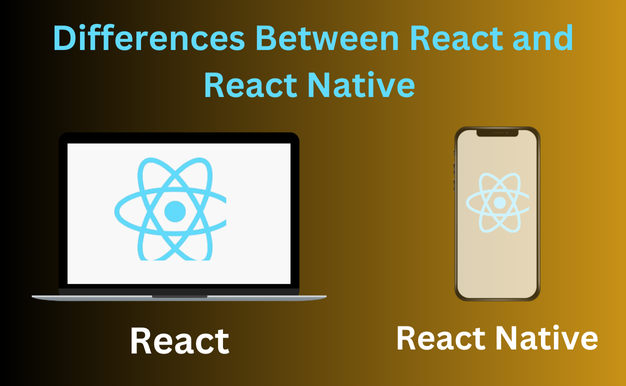December 1, 2024
Differences Between React and React Native Explained Step-by-Step

Web and mobile app development, two powerful JavaScript libraries, React and React Native, have emerged as popular choices. Whether you choose React for web development or React Native for mobile app development, partnering with a skilled development team is key to your project’s success.
This guide takes you on a step-by-step journey to understand the differences between React and React Native, helping you decide which technology might be the best fit for your project
Top 5 Differences Between React and React Native.
1. Target Platform: Web vs. Mobile
The most fundamental difference lies in the target platform each technology caters to:
React: Shines in the world of web development. Think of it as a powerful toolkit specifically designed to build user interfaces (UIs) for websites and web applications. With React, you can create dynamic and interactive web pages that come alive with user interaction, like smooth animations and constantly updating content. For a seamless web application experience, hire react developer Imagine crafting an engaging online store where product details seamlessly change as you hover over different items, or building a social media platform where newsfeeds update instantly with every new post. React empowers you to bring these web experiences to life.
React Native: Ventures into the realm of mobile development. It allows you to leverage JavaScript and React-like concepts to build native mobile applications for both iOS and Android devices. Imagine using familiar tools to create apps that feel right at home on smartphones and tablets, with features like touch gestures and device-specific functionalities. Think building a fitness app that can access the phone’s gyroscope for step tracking, or developing a language learning app that leverages the device’s microphone for voice recognition exercises. React Native allows you to create feature-rich mobile applications that seamlessly integrate with the functionalities of the underlying device.
2. User Interface (UI) Building Blocks:
The way these technologies construct the visual elements of your application differs:
React: Employs a component-based architecture. Complex UIs are broken down into smaller, reusable components, like building blocks. These components can be anything from a simple button to a complex navigation bar. This modular approach allows for efficient development – you can create reusable components that can be combined and customized throughout your web application. Imagine building a house – you wouldn’t build each wall from scratch, you’d use pre-made bricks. Similarly, React components allow you to develop UIs faster and easier, while also promoting cleaner and more maintainable code.
React Native: Utilizes native UI components specific to each mobile platform (iOS or Android). This ensures your app inherits the familiar look and feel of the device it’s running on, providing a seamless user experience for mobile users. Imagine building an iPhone app that has the same intuitive gestures and design elements as other iPhone apps – that’s the power of native UI components. React Native allows you to develop mobile apps that feel like natural extensions of the iOS or Android ecosystem, fostering a sense of familiarity and ease of use for mobile users.
3. Code Reusability: One Codebase vs. Platform-Specific Development
A key consideration is how much code you can reuse between platforms:
React: Limited code reusability. The code you write for a web application in React typically won’t work directly on mobile devices. While React offers libraries and tools to create mobile-like experiences within web apps, it’s not designed specifically for native mobile development.
React Native: Offers the potential for cross-platform development. With React Native, you can potentially write a significant portion of your application logic in JavaScript and then leverage platform-specific components to render the UI elements for each mobile platform (iOS and Android). This can be a significant time-saver, especially if you want to reach a broad mobile audience without having to develop separate apps from scratch for each platform. Imagine writing the core functionalities of your app once and then customizing the visual design to fit the specific look and feel of iOS and Android devices. React Native allows for this level of code reusability, streamlining the mobile app development process.
_______________________________________________________________________________________________________
Read More-: Top 10 Platforms for Recruiting Developers
_______________________________________________________________________________________________________
4. Development Experience: Web vs. Mobile Expertise
The development skills required for each technology differ slightly:
React: A good fit for developers with experience in JavaScript and web development concepts. The learning curve for React itself is manageable, especially for those already familiar with JavaScript and web development principles. Many developers find the component-based architecture and declarative style of React intuitive to learn and work with.
React Native: While it also uses JavaScript, React Native requires an understanding of mobile development concepts and potentially some platform-specific knowledge (iOS or Android). Understanding how mobile apps interact with device features like cameras or GPS might be necessary. If your team lacks experience in mobile app development, additional learning or hiring developers with mobile expertise might be necessary.
5. Performance and User Experience:
Both technologies strive to deliver a smooth and responsive user experience, but the approach differs:
React: Relies on the web browser to render the UI. While React utilizes techniques like the virtual DOM to optimize performance, the overall user experience can sometimes be influenced by factors like the user’s internet connection speed and device capabilities.
React Native: Leverages the native capabilities of the underlying mobile platform (iOS or Android) to render the UI. Building a cross-platform mobile app? hire react native developer. This often results in a smoother and more responsive user experience, feeling more akin to traditional native mobile apps. Imagine scrolling through a news feed on your phone – a native app built with React Native might feel smoother and more responsive compared to a web app built with React, especially if you have a slower internet connection. React Native takes advantage of the device’s hardware and software for a more optimized mobile experience.
Choosing the Right Tool for the Job
Now that you understand the key differences between React and React Native, you can make an informed decision about which technology best suits your project needs:
For Web Applications: React is the clear choice for building user interfaces for websites and web applications. Its component-based architecture, virtual DOM, and focus on web development make it a powerful tool for creating dynamic and interactive web experiences.
For Mobile Applications: If you’re looking to develop mobile apps for iOS and Android, React Native offers a compelling solution. With its ability to leverage native UI components and achieve cross-platform development, it streamlines the mobile app development process. However, consider your team’s experience and the complexity of your mobile app when making your decision.
Conclusion
Ultimately, both React and React Native are powerful tools in the hands of skilled developers. By carefully considering your project’s requirements and your development team’s expertise, you can choose the technology that empowers you to bring your vision to life! But for those new to the world of development, differentiating between these two can be confusing.





